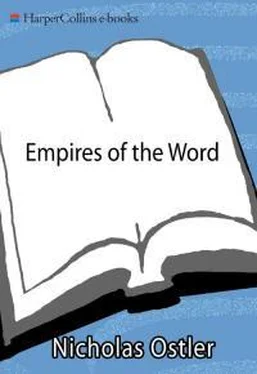The original name was Kiang alone, an Austro-Asiatic word, related to words for ‘river’ in Vietnamese song (once pronounced ’krong’ ) and Mon kruŋ , showing the kind of language spoken here before Chinese came in from the north (Norman 1988: 18).
Compare san , ‘brother’, with sānat , ‘sister’. Most abstract nouns share this femininity, e.g. maR ’at , ‘righteousness’ (always conceived as a goddess). See pp. 35ff. for a longer description of Semitic features.
This common word for the king of Egypt was established by its use in the Hebrew Bible. It represents the Egyptian pr- ’r (House-Great), and so is like using ‘the Palace’ to refer to the British monarch.
The name Memphis actually refers to King Pepi’s pyramid there, built some seven hundred years later: ‘stable in beauty’. Egypt is inexact as a name for the country. Reflecting the Greek word Aiguptos , it is in fact a title of Memphis: a slurring of ḥəyt kRUW ptaḥ , ‘temple of the Ka-energy of Ptah’. kruw was the sustenance to the life force kaR , given by food and drink, and sacrificial offerings.
Based in Sarw (Sais) in the Delta area, they are rumoured to have been of Libyan ancestry.
Yet, when the hero of the fictional Tale of Sinuhe reached Retjenu, in northern Palestine (the tale is set at the end of the twentieth century BC, with Retjenu ranged with Egypt’s enemies), he was told: ‘You will be happy here. You will hear the language of Egypt.’ As Sinuhe recounts, there were already Egyptians with the ruler of Retjenu, who had spoken up for him (verse 30). The ruler’s name was Ammulanasi, recognisably Amorite.
Herodotus, ii. 154, recounts that Psamtek put some Egyptian boys into the service of the Ionians and Carians, to be taught Greek, and thereby founded the Egyptian caste of interpreters. There is no reference to any Greeks studying Egyptian.
Plutarch, Antony , xxvii.4-5. All these languages must have been heard on the streets of Alexandria in Cleopatra’s day. Ethiopian would be the language of Kush, and Syriac is a form of Aramaic. Trogodyte would have been spoken along the Red Sea coast, and is perhaps the ancestor of modern Beja. The Medjay , supposed to be the same, had been an eastern desert people employed in Egypt as police in the fifteenth to thirteenth centuries (Gardiner 1957: 183, n. 2). There is no mention here of Libyan—or of Latin, although Plutarch adds that Cleopatra is said to have spoken many other languages besides the ones he does mention. Most likely her amours with Caesar, and later Antony, were conducted in Greek.
The last inscription was made on the sacred island of Philae, just above the Nile’s first cataract and symbolically the farthest outpost of the land of Egypt. The final desecration of the shrine, the last as well as the farthest in Egypt, was ratified by the Roman emperor Justinian (Johnson 1999: 229).
Materials for writing changed over the millennia. For the early period our knowledge of what was current is of course reliant on its durability, hence the early prominence of bronze and bone. Later on (from the first millennium) the brush was used to write on strips of bamboo. More flexible materials, distinctive Chinese inventions, came later: rolls of silk from the second century BC, and paper from AD 105. Printing too was a Chinese contribution to world language technology: fixed blocks were cut to print whole pages from the end of the ninth century AD, and movable type was introduced from the eleventh. Naturally this last was harder work with a writing system that has always used several thousand symbols.
Mencius ( c. 250 BC according to Brooks 2002), 3.B.6: ‘Suppose some great officer of Chu wanted his son to learn to speak Qi …’ Evidently, the ambitious were already setting themselves to learn Chinese. Qi was approximately modern Shandong, at the mouth of the Huang-he, and so at the centre of the spread of Chinese. Strangely, a text written only a decade or so later seems to pick Chu to contrast with an eastern barbarian language: ‘Let a Chu man grow up among Rong, or a Rong man grow up in Chu, and the Chu man will speak Rong, while the Rong man will speak Chu’ ( Lushi Chunqiu , 4.E).
These moves can be compared with the depopulations ordered by the kings of Assyria and Babylon after major military victories. (See Chapter 3, ‘Akkadian—world-beating technology: A model of literacy’, p. 64.) But since the Mesopotamian kings saw the greatest threat in foreigners, they ended up seeding their empire with a foreign language, Aramaic; the Chinese emperor, seeing threat in Chinese feudal lords, disseminated them (and therewith the Chinese language) to the farthest corners of his realm.
This is often proposed as the etymology for the name China , a name that seems to have reached the West through Persian and Italian. But the Chinese use rather the names of the Han or Tang dynasties as the name of their nation, and the form of the name suggests that it is derived from the Sanskrit name, Cīna. This applied mainly to the area of Tibet, though also on occasions included Assam and Burma (Sircar 1971: 104-5). China as a whole was known to the Indians as Mahācīna , ‘Great China’: this, for example, is where the Chinese pilgrim Xuan Zang told the Indians he was from, when he visited in 629. Si-Yu-Ki, v. 1 (in Beal 1884, part 1: 216).
The Altai mountains of central Asia, the source of this name, are themselves named for their gold: cf. Turkish altin.
This looks very much like a Chinese rendition of Hunnu , which would allow these people to be identified with those known to the Indians as Hūna , and to the Europeans as Hunni. But the phonetic resemblance unfortunately remains the only strong evidence. (See Sinor 1990: 177-9.)
Called in modern Chinese Tùobá , using characters  that at the time would have been pronounced Tak-B’uat. The name has become the modern Chuvash: it still designates a Turkic-speaking people of whom there are 1.5 million scattered across Russia and Siberia (Clauson 2002 [1962]: 38; Dalby 1998: 134-5).
that at the time would have been pronounced Tak-B’uat. The name has become the modern Chuvash: it still designates a Turkic-speaking people of whom there are 1.5 million scattered across Russia and Siberia (Clauson 2002 [1962]: 38; Dalby 1998: 134-5).
The Statute of Kilkenny was passed in 1366, requiring the English colonists (section III) ‘to use the English language, and be called by an English name, leaving off entirely the manner of naming used by the Irish …’
Briefly put, northern Chinese lost all its final consonants; and strings of previously free monosyllables became congealed into longer words. No one knows why, but some explanations for the changes have been proposed. Perhaps the semantic vagueness of Chinese morphemes, after losing so many distinctive consonants, meant that reinforcing one word with another was necessary in order to communicate effectively. Perhaps the sheer phonetic weakness of the new shorter syllables meant that doubling up had to occur to give the language an acceptable speech rhythm (Feng 1998). Perhaps the advent of Buddhism, with chanting in Sanskrit and Pali which introduced longer words, and the complicated expressions that arose when they were translated into Chinese, inured people to polysyllabism. The various trends and possible influences are clearly discussed in Wilkinson (2000:31-40).
Читать дальше

 that at the time would have been pronounced Tak-B’uat. The name has become the modern Chuvash: it still designates a Turkic-speaking people of whom there are 1.5 million scattered across Russia and Siberia (Clauson 2002 [1962]: 38; Dalby 1998: 134-5).
that at the time would have been pronounced Tak-B’uat. The name has become the modern Chuvash: it still designates a Turkic-speaking people of whom there are 1.5 million scattered across Russia and Siberia (Clauson 2002 [1962]: 38; Dalby 1998: 134-5).









